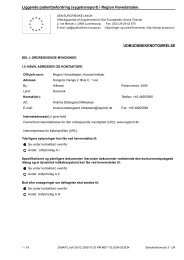Territorial Review Copenhagen - Region Hovedstaden
Territorial Review Copenhagen - Region Hovedstaden
Territorial Review Copenhagen - Region Hovedstaden
You also want an ePaper? Increase the reach of your titles
YUMPU automatically turns print PDFs into web optimized ePapers that Google loves.
160<br />
of demand management tool in the world, linking the demand for the road to the<br />
supply of the road (road capability of achieving reasonable automobile speed).<br />
Nagoya (Japan): The city of Nagoya, headquarters of one of the biggest<br />
automobile companies, Toyota, decided to make an experiment of a congestion<br />
charge for a trial period from October to December, 2008. The aim was to<br />
decrease congestion and CO 2 emission. Car usage accounts for 42% of all<br />
transportation modes in the city. By 2030, the city wants to decrease the<br />
percentage to 35%, by increasing the use of public transportation. The city plans<br />
to return a portion of parking fees to drivers, while giving no return to the<br />
illegally parking cars and through-traffic cars. This return is pending agreement<br />
from the residents of the charged area. This is the first experiment of a<br />
congestion charge in Japan and will be a touchstone for other Japanese cities.<br />
Costs of congestion charges are considerable, but recent experiments<br />
show net benefits for <strong>Copenhagen</strong>. Experiments conducted in <strong>Copenhagen</strong><br />
suggest that congestion charges would have led to reductions in congestion<br />
in <strong>Copenhagen</strong> had it been introduced in 2005, ranging from a reduction of<br />
0.2% in the small toll ring to 7% under the kilometre-charging system. An<br />
analysis in 2008 by Kommuneforum, a group of municipal representatives<br />
in the Capital <strong>Region</strong>, showed that the introduction of congestion charges in<br />
2010 could reduce traffic in the payment area by 15% (Kommuneforum,<br />
2008). Different charging schemes affect the origin-destination pattern<br />
differently. Cordon-based charging efficiently reduces the traffic across<br />
cordons, but tends to leave internal traffic unchanged (Schönfelder, 2007).<br />
Introduction in 2005 would have resulted in negative internal rent as<br />
congestion in <strong>Copenhagen</strong> was modest (Rich and Nielsen, 2007). Reflecting<br />
increased congestion and increasing traffic streams into <strong>Copenhagen</strong>,<br />
calculations in 2008 pointed to a net benefit of DKK 1.5 billion per year if<br />
congestion charges had been introduced in 2010 (Kommuneforum, 2008).<br />
Political support for congestion charges exists in the city of <strong>Copenhagen</strong><br />
and 15 neighbouring municipalities (known as ―The Forum of<br />
Municipalities‖), but is lacking among other relevant actors. The current<br />
Lord Mayor of <strong>Copenhagen</strong> has been a strong advocate for road charging,<br />
supported by a majority in the City Council. The kilometre-based tariff<br />
system is considered to be the most favourable option, but its technology is<br />
considered to be risky. In order to introduce a charging system as quickly as<br />
possible, the municipality has favoured a toll ring. According to Danish law,<br />
road charges are considered a general tax and therefore have to be decided<br />
by the national Parliament, which has so far opposed road pricing, despite<br />
the strong support of some members.<br />
There seems to be popular support for road charging. Opinion polls<br />
show that the local population is predominantly in favour of road pricing,

















